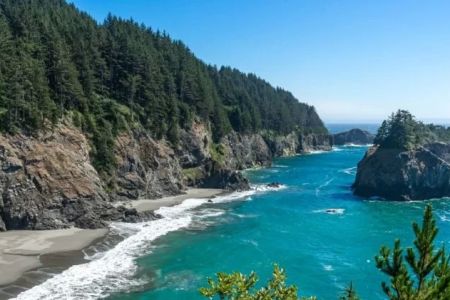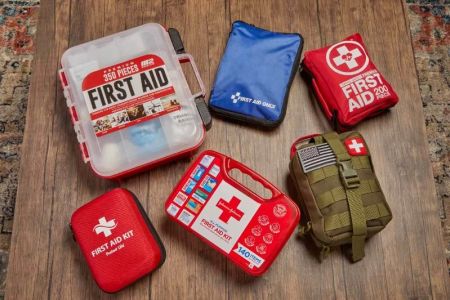Road-Trip Risks and Why First Aid Kits Matter
A long drive in the United States can cover everything from high-altitude passes and salt-white deserts to humid coastal highways and remote backroads with no cell service. That range of environments is exactly why The Best First Aid Kits for US Road Trips are not just about bandages in a plastic box; they are portable response systems that buy you time, reduce panic, and keep minor issues from spiraling. Think about the most common road-trip injuries and illnesses: blistered heels after an impromptu canyon hike, a gnarly sunburn from an overlook stop, a finger sliced by a camp-kitchen can lid, motion sickness on winding byways, a bee sting at a rest area, or dehydration during a summer traffic jam. Each is manageable—if you have the right supplies and know where they are.
Modern vehicles carry airbags and spare tires, but very few drivers carry a medical kit tuned to their actual route, weather, and passengers. If you’re crossing the Southwest in July, heat and dust drive your kit choices; if you’re threading the Blue Ridge Parkway in spring, altitude changes and pollen matter more. Families with kids need extra wound-care and fever reducers; pet parents need paw-safe antiseptics and bandage wraps. Solo travelers might prioritize compact size and simple instructions. The guiding idea behind The Best First Aid Kits for US Road Trips is fit-for-purpose: pick what you’ll really use, plan for the risks you’ll actually see, and keep it reachable in seconds—not buried under luggage.
There’s also the emotional side. A clearly labeled, well-organized kit calms everyone down. When someone asks, “Do we have antihistamines?” you want to say yes and know exactly where. That confidence saves time and supports better decisions, especially if you’re miles from the nearest pharmacy. Throughout this guide, we’ll show how to match kit contents to itineraries, how to store and maintain gear, and how to translate a bulleted checklist into a kit you trust. For curated gear picks and route-specific advice, you can always consult Refined Travel for updated recommendations and availability on trusted travel-ready kits and accessories.
What Makes a Great Road-Trip First Aid Kit
Excellent road-trip kits nail three things: coverage, organization, and durability. Coverage means addressing the issues you’re most likely to face on US highways—cuts, scrapes, blisters, burns, stings, sprains, headaches, GI upsets, allergies, and dehydration—as well as less frequent but higher-impact problems like heavy bleeding or impaired breathing due to severe allergic reactions. Organization turns a bag of supplies into a system: color-coded pouches, clear labels (“bleeding,” “burns,” “meds”), and quick-open zippers. Durability keeps everything intact when the kit lives in a hot trunk, under a seat, or in a dusty cargo bin.
Here’s how those principles translate into components commonly found in The Best First Aid Kits for US Road Trips:
1) Wound care: adhesive bandages in multiple sizes, sterile 4×4 gauze pads, rolled gauze, butterfly closures, moleskin for hot spots, antiseptic wipes, povidone-iodine or chlorhexidine swabs, hydrogel pads for burns, and medical tape that sticks in heat and humidity.
2) Tools: trauma shears, fine-tip tweezers (ticks, splinters), safety pins, digital thermometer, instant cold packs, elastic bandage wrap, triangular sling, CPR barrier, and a compact headlamp so you’re not fumbling with a phone light at night.
3) Medications (travel sizes): ibuprofen/acetaminophen, antihistamines (sedating and non-sedating), loperamide and oral rehydration salts, antacids, motion-sickness tablets, hydrocortisone cream, antibiotic ointment, and glucose tablets for sudden lows if anyone in your party is at risk.
4) Protection & comfort: nitrile gloves, hand sanitizer, sunblock packets, lip balm with SPF, electrolyte sticks, and a compact mylar blanket (also handy if someone gets chilled after heat exhaustion).
5) Documentation: quick-reference first-aid guide, personal med lists, known allergies, and emergency contacts tucked into a waterproof sleeve.
Size is the trap many travelers fall into. The “biggest kit” isn’t automatically the best. A glove-box kit you actually reach for beats a 10-pound duffel you leave in the garage. The right kit for a couple weekenders will differ from what a family of five needs for ten days across national parks. And remember temperature swings: gels and bandages can degrade in a summer trunk. Quality counts; that’s where curated picks from Refined Travel shine, focusing on heat-resistant packaging, strong adhesives, and smart layouts that survive real-world use.
Prebuilt Kits vs DIY—Which Works Better?
Prebuilt kits promise convenience. You get a tidy pouch with “everything you need” and neat labels. For many road-trippers, especially first-timers, that’s enough—and it’s a big step up from carrying nothing. But read the contents list carefully. Some bargain kits pad the count with dozens of tiny bandages and skimp on essentials like rolled gauze, elastic wraps, or real shears. Premium, road-focused kits tend to include sturdier tools, larger dressings, and instruction cards with diagrams.
DIY kits, on the other hand, let you tailor exactly to your crew. If someone is prone to blisters, you can add moleskin and hydrocolloid dressings. If a traveler has seasonal allergies, include both fast-acting and long-acting antihistamines. Families might pack children’s dosing and a dosing syringe; pet owners can add vet-approved antiseptic and self-adhering wrap. The trade-off is time and the risk of forgetting something critical. Many experienced travelers use a hybrid approach: start with a vetted prebuilt kit from a trusted source, then top it up with route-specific items. This “base-plus” strategy is a hallmark of The Best First Aid Kits for US Road Trips because it saves prep time while covering real needs.
Cost-wise, a reliable prebuilt kit is often cheaper than purchasing every item à la carte, especially when you factor in a durable pouch and quality tools. If you go DIY, resist the temptation to grab random items from a bathroom cabinet. Travel-grade packaging (think tear-resistant, waterproof sachets and sturdy vials) prevents leaks and disintegration under heat and vibration. If you’d like a starting point, browse the curated “base-plus” combinations at Refined Travel—the selections focus on reliable components that perform on the road rather than just look good on a checklist.
Packing by Scenario: From Deserts to Mountains
The United States is a patchwork of microclimates, and the route you choose should steer your kit decisions. For a Sonoran Desert run in June, the ticket is hydration support and heat management: oral rehydration salts, electrolyte sticks, sunburn gels, wide-area dressings for heat rash, and extra nitrile gloves (sweaty hands make bandaging harder). Add a pocket mirror to check eyes for blown dust and a sterile saline ampule for rinsing. In contrast, a Pacific Northwest loop in October calls for moisture-resistant bandages, blister prevention, and warm packs to help after a surprise downpour and a cold camp evening.
High-altitude drives—say, Trail Ridge Road or Beartooth Highway—add sun intensity and dehydration. Prioritize SPF packets, lip balm, and extra water purification tabs for impromptu hikes. In tick country (Upper Midwest, New England), fine-tip tweezers, tick-removal instructions, and alcohol wipes are non-negotiable. Coastal routes invite jellyfish stings and abrasions from shells; vinegar packets and hydrocortisone cream help. For long interstate slogs with kids, plan for motion sickness and snack-related tummy issues; pack loperamide, kids’ electrolyte powder, and a change of clothes sealed in a compression bag.
Seasonality matters too. Winter road trips mean gloves you can treat in, thermal blanket backups, and wound supplies that still adhere in the cold. Store gels and liquids in the cabin rather than the trunk to prevent freezing. Summer flips the script: heat threatens adhesives and medications. Keep your kit in a shaded cabin location or a small insulated pouch. The key takeaway: the phrase The Best First Aid Kits for US Road Trips is not a one-size product; it’s a strategy shaped by geography, season, and passengers.
How to Store, Maintain, and Audit Your Kit
A first aid kit you can’t find in ten seconds is a box of stress. Make it muscle memory: driver’s door pocket for gloves and a mini bleeding pack; center console for meds; trunk side bin for the full kit. Use bright, contrasting colors and big pull tabs. Label pouches by function—“bleeding,” “burns,” “blisters,” “meds”—so a partner can grab the right one when you’re driving. Consider a small secondary kit that lives in a daypack for overlooks and trail detours.
Auditing is simple: set calendar reminders at the start of summer and winter. Check expirations, adhesives, and batteries. Replace what’s used (it’s easy to forget you raided the kit for a home paper-cut). Heat-cycled trunks can wreck tape and bandages; touch-test and toss anything that has lost tack. Keep a tiny log tucked inside—date, what you used, and any notes (“need more 4×4s”). That running record turns your kit from a one-time purchase into a maintained system worthy of the name The Best First Aid Kits for US Road Trips.
Finally, store with safety: medications in child-resistant vials, cutting tools sheathed, and sharps kept in a small, rigid container. If you travel with pets, segregate animal supplies and keep chocolate or xylitol-containing items out of reach. Organization beats improvisation every time.
Real Stories from the Road: What Saved the Day
“The Vista Point Glass Cut.” On a Utah overlook, a traveler set a water bottle on a guardrail; a gust knocked it off and glass shattered. A deep palm slice bled fast. Their kit’s hemostatic gauze, pressure wrap, and a clean water squeeze bottle stabilized the wound in minutes, avoiding a risky, dusty drive with uncontrolled bleeding. The ER nurse later said the pressure wrap likely prevented stitches from becoming a bigger problem.
“Bee Season on I-95.” A family picnic near a rest area turned chaotic when a child took a sting on the lip. The car kit’s cold pack, oral antihistamine (child dosing noted on the pouch), and hydrocortisone made an immediate difference, and a clear care card kept the parents calm while they watched for red-flag symptoms. They still detoured to urgent care, but those first ten minutes changed the day.
“Trailhead Turnaround.” A couple underestimated a steep trail in Colorado and came back with brutal heel blisters. Their kit—pre-cut moleskin, alcohol swabs, and hydrocolloid pads—kept the rest of the trip on track. The lesson: preventive supplies are quality-of-trip savers, not mere “extras.”
These stories are why we keep repeating the phrase The Best First Aid Kits for US Road Trips. It’s not hype; it’s a practical filter for choosing gear that turns emergencies into manageable hiccups. For route-tailored selections, travelers often check Refined Travel for up-to-date availability, recommendations based on season, and concise packing notes you can screenshot for the glove box.
Expert Checklist, Pro Tips, and Common Myths
Quick Essentials Checklist: assorted bandages, 4×4 gauze, rolled gauze, moleskin, hydrocolloid pads, antiseptic wipes, antibiotic ointment, hydrocortisone cream, oral pain reliever, antihistamines (two types), loperamide, antacid, oral rehydration salts, electrolyte sticks, instant cold packs, elastic wrap, triangular bandage, trauma shears, tweezers, CPR barrier, thermometer, nitrile gloves, hand sanitizer, sunblock packets, lip balm, mylar blanket, headlamp, instruction card, personal med list.
Pro Tips: pre-stage a “bleed pack” in a red zip pouch; keep child meds and dosing tools together; laminate a one-page quick guide; stash a spare pair of glasses or contacts solution; add a small roll of duct tape (splints, temporary fixes); pack glucose tabs if anyone is at risk of lows; keep a spare zip bag for used dressings.
Myths to Ditch: “Big kit equals better kit” (only if you can use it fast), “Band-Aids cover most issues” (not for sprains, rashes, or GI problems), “I can buy what I need when I need it” (not at 9pm in a rural stretch), and “First aid is only for injuries” (heat, altitude, and allergies are just as common on US routes).
If you prefer not to build from scratch, seek kits with transparent contents, lot numbers, and real tools. Curated options showcased by Refined Travel emphasize practical components over marketing filler and come with route-specific add-on modules—ticks for New England, heat for the Southwest, moisture for the Pacific Northwest.
Choosing the Right Kit for Your Vehicle and Crew
The best kit for a compact car differs from what you’ll stash in a camper van or SUV. In smaller vehicles, a glove-box mini for immediate needs plus a trunk midsize kit is a smart pairing. SUVs can dedicate a rear-door pocket to a clearly labeled trauma pouch and keep the full kit under a cargo cover. RV travelers might combine a home-style cabinet kit with a grab-and-go pouch for trailheads. Consider passengers: babies call for thermometer covers, dosing syringes, diaper-rash cream, and extra sanitizer; seniors may need pill organizers, larger-print instruction cards, and joint-support wraps.
Budget and sustainability matter too. A mid-tier kit with refillable modules often beats a cheap disposable box. Refills are cost-effective and cut waste. Choose materials that hold up to road grit and sun: rugged zippers, ripstop fabric, waterproof inner bags. When in doubt, look for clear return/refill pathways and documentation—features that vetted picks at Refined Travel prioritize so you can maintain readiness without rebuilding from zero.
Above all, train the team. Spend ten minutes at the first gas stop to show everyone the layout. Practice opening cold packs and applying wraps. Confidence is cargo you can’t buy at a rest stop, but with the right kit—truly The Best First Aid Kits for US Road Trips for your route—you can carry it the whole way.







